|
|
|
Sort Order |
|
|
|
Items / Page
|
|
|
|
|
|
|
| Srl | Item |
| 1 |
ID:
093563
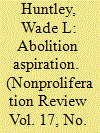

|
|
|
|
|
| Publication |
2010.
|
| Summary/Abstract |
The goal of abolishing all nuclear weapons has often seemed unrealistic, if not utopian. The Cold War posed intractable apocalyptic dangers, and the post-Cold War "peace dividend" proved scant. But over the decades, nuclear arms control and nonproliferation successes have been as important as the setbacks, and in 2010 the abolition aspiration has made something of a comeback. This article surveys the most important challenges facing nuclear disarmament progress today. The article considers the interrelationships among the positions of the key categories of states shaping the contemporary global nuclear order, for good or ill, as a capstone to the other pieces in this special section, which focus on those categories individually. The article concludes that progress toward disarmament will not be easy or fast. Weaning states off their reliance on threats to either use or acquire nuclear arms requires progress in improving the conditions of global governance more generally. But the goal of eliminating the threat of nuclear weapons is a realistic prospect and, consequently, an essential imperative.
|
|
|
|
|
|
|
|
|
|
|
|
|
|
|
|
| 2 |
ID:
093560
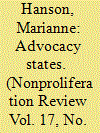

|
|
|
|
|
| Publication |
2010.
|
| Summary/Abstract |
While the current momentum for the elimination of nuclear weapons can be traced in part to the highly influential 2007 and 2008 Wall Street Journal opinion articles by George Shultz, William Perry, Henry Kissinger, and Sam Nunn, a more accurate picture of this momentum must take into account the role played by what are called here the "advocacy states." Motivated by a combination of humanitarian and strategic concerns, and mindful of the dangers of deterrence as well as proliferation, accidental use, and terrorist acquisition of nuclear material, these states have, for the past fifteen years, mounted a steady and repeated call for nuclear disarmament. Their activities have taken two main forms: the preparation of various state-sponsored reports investigating the utility and attendant dangers of nuclear weapons and making a strong case for nuclear disarmament; and the formation of like-minded groupings of states, namely in the New Agenda Coalition and the Seven-Nation Initiative, that are active in diplomatic forums and in practical projects. This article assesses the advocacy states' activities and shows that the states' reports and groupings increasingly focus on providing research, expertise, and technical assistance for the challenges facing disarmament. The article examines briefly the question of extended nuclear deterrence and disarmament (given that many of the advocacy states are Western allies) and considers the likely future role and activities for advocacy states. The author argues that these states have played a vital role in creating a climate in which the Obama administration can engage the movement toward disarmament.
|
|
|
|
|
|
|
|
|
|
|
|
|
|
|
|
| 3 |
ID:
093562
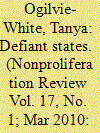

|
|
|
|
|
| Publication |
2010.
|
| Summary/Abstract |
This article explores the potential impact of U.S. disarmament leadership on the nuclear diplomacy of North Korea and Iran, the "defiant states." The first part of the article introduces the concept of "interaction capacity," which measures a state's integration into international society, based on its physical communication systems and its adoption of shared norms. The theory predicts that lower levels of interaction capacity will generate a greater propensity for nuclear defiance, as the affected states reject and try to resist integration pressures. In the second and third parts of the article, this conceptual framework is applied to the cases of North Korea and Iran. The analysis suggests that efforts to reassert U.S. disarmament leadership could increase the alienation of North Korea and Iran, leading to provocation and escalation of nuclear tensions. The final part of the paper explores the policy implications of this analysis for the potentially defunct six-party talks, for hopes of renewed negotiations with Iran, and for the 2010 Review Conference of the Treaty on the Non-Proliferation of Nuclear Weapons.
|
|
|
|
|
|
|
|
|
|
|
|
|
|
|
|
| 4 |
ID:
093557


|
|
|
|
|
| Publication |
2010.
|
| Summary/Abstract |
This special section examines the disarmament dynamics being generated by President Barack Obama and other world leaders in their advocacy of a nuclear-weapon-free world. It explores the responses of five groups of states (nuclear weapon states, threshold states, advocacy states, holdout states, and defiant states) to the new disarmament momentum, assessing whether a global consensus on-and concrete progress toward-nuclear elimination is likely. The main goals of this special section are: to generate scholarly debate on this important subject (the literature has tended to focus on understanding proliferation rather than disarmament dynamics); and to examine the potential consequences of reinvigorated disarmament leadership for the upcoming Review Conference of the Treaty on the Non-Proliferation of Nuclear Weapons, which will be held in New York City in May 2010.
|
|
|
|
|
|
|
|
|
|
|
|
|
|
|
|
| 5 |
ID:
093561


|
|
|
|
|
| Publication |
2010.
|
| Summary/Abstract |
This article assesses the impact of the U.S.-led disarmament agenda on the disarmament diplomacy and policies of the three nuclear-capable states not party to the Treaty on the Non-Proliferation of Nuclear Weapons (NPT)-India, Israel, and Pakistan. These states, often referred to as "NPT holdouts," undermine the application of the NPT obligations on all parties. Universality of the treaty framework has long been considered vital to strengthen the nuclear nonproliferation regime and consolidate non-nuclear norms. But can new U.S.-led disarmament momentum create the necessary dynamics to encourage the holdouts to disarm, or is this wishful thinking? This article argues that sustained disarmament momentum from the Western NWS will not be enough-a more comprehensive approach to disarmament is needed, including a genuine commitment by all NWS to engage in transparency and reductions, and full nuclear compliance and cooperation by Iran.
|
|
|
|
|
|
|
|
|
|
|
|
|
|
|
|
| 6 |
ID:
093559
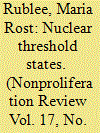

|
|
|
|
|
| Publication |
2010.
|
| Summary/Abstract |
"Nuclear threshold states"-those that have chosen nuclear restraint despite having significant nuclear capabilities-seem like the perfect partners for the reinvigorated drive toward global nuclear disarmament. Having chosen nuclear restraint, threshold states may embrace disarmament as a way to guarantee the viability of their choice (which may be impossible in a proliferating world). Supporting disarmament efforts affirms their restraint, both self-congratulating and self-fulfilling. Additionally, the commitment to their non-nuclear status springs at least in part from a moral stance against nuclear weapons that lends itself to energetic support of global disarmament. However, threshold states also offer significant challenges to the movement for nuclear weapons elimination, in particular in relation to acquisition of enrichment and reprocessing facilities. This article analyzes both the challenges and opportunities posed by threshold states by examining the cases of Brazil and Japan.
|
|
|
|
|
|
|
|
|
|
|
|
|
|
|
|
| 7 |
ID:
093558


|
|
|
|
|
| Publication |
2010.
|
| Summary/Abstract |
The nuclear weapon states (NWS) have different perspectives on the desirability and feasibility of a world without nuclear weapons. A review of each of the current nuclear doctrines, postures, and disarmament policies of the five NWS shows that there is a clear divide between them, with some showing relatively determined leadership (the United States and the United Kingdom) and others expressing skepticism, if not complete disinterest (France, Russia, and China). Nevertheless, the prospects for progress on disarmament by the NWS at the 2010 Review Conference of the Treaty on the Non-Proliferation of Nuclear Weapons remain reasonably good. Yet complete success will require much time as well as sustained and applied efforts from the NWS, first and foremost to improve their performance as international security guarantors.
|
|
|
|
|
|
|
|
|
|
|
|
|
|
|
|
| 8 |
ID:
093564
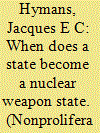

|
|
|
|
|
| Publication |
2010.
|
| Summary/Abstract |
When does a state become a "nuclear weapon state"? How we choose to answer this question has significant implications for proliferation assessment, analysis, and policy. Traditionally, the standard demarcation line has been a state's first nuclear test, but in recent years analysts have increasingly focused instead on the accumulation of a significant quantity (SQ) of fissile material. The article argues that although the test/no-test indicator clearly has problems, its replacement by the SQ/no-SQ indicator would be highly counterproductive. The article instead proposes supplementing the traditional test/no-test indicator with a theory-driven approach that focuses on the incentives and disincentives to test.
|
|
|
|
|
|
|
|
|
|
|
|
|
|
|
|
|
|
|
|
|